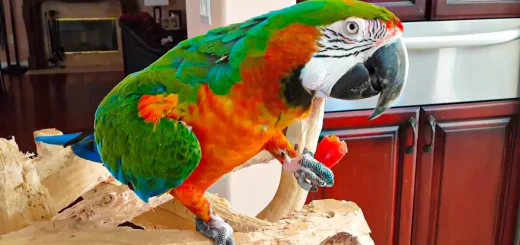Blue and Gold Macaw Species Parrot

Description of the Blue and Gold Macaw
The beautiful, impressive, cute, and majestic; blue and gold Macaw has been held for years as one of the most popular big parrots. These bright colored beauties have much to offer than just a beautiful face – they are full of personality as well! They are in fact one of the more recognized birds in the world and a popular pet for the public who can handle large parrots demanding attention.
Common names
Blue and Gold Macaw, Blue and Yellow Macaw
Origin and History
Wild, blue and gold macaws enjoy a wide range of Central American Panama, extending to almost every country in North-South America. They have been launched in Puerto Rico.
Blue and gold usually live in forests near rivers and stalks, though tall trees are available so they can be found in savannas. In most cases, the pair are seen, at certain times of the year, and a large number of macaws will be assembled for food in the morning and evening.
Wild blue and gold are an endangered species. The majority of their population is due to habitat destruction, hunting, and trapping. Often, birds intended for the trade of birds are taken directly from the bird and many protective parents die while protecting their young.
Blue and gold macaws are considered to be monotypic, which means that there is only one bird in the species. However, bird experts are arguing that there should be two, which some subspecies consider. This Bolivian blue and gold macaw has a larger bird in true blue than a typical bird. The other is a blue threaded macaw, which has a sesame blue neck instead of black. Blue and gold were born in the United States since 1935, among the most popular and common breeds of macaws kept as pets. Breeds are readily available and their spread makes them one of the most affordable large parrots.
Volume
Blue and gold macaws can reach up to 33 inches from the beak at the end of the larger fins and tailfeathers. Their wingspan reaches a staggering 40 inches or more, and they usually weigh more than 2 pounds at maturity.
Average lifespan
Like the biggest parrots, taking in blue and gold macaw is a commitment to live because they can live 60 or more years. Although most of the 30-year-olds live, the story of the blue and gold lives in 100. In particular, an English Macau named Charlie was born in 1899 and celebrated his 114th birthday in 2013. Its owner also claimed that Winston Churchill once owned it, but it was disputed.
The mood
Intelligent and collective, blue and gold macaw usually work well as a pet while the owners are dedicated, responsible and well known. They are big birds, and capable of such extremely strong vocalizations. Because of this, they may not be the best choice for those living in apartments and condominiums or who have young children.
If allowed to socialize with different people, the blue and gold macaw is very well adapted to different situations. They are untitled popular at bird shows and many owners take them in and out of town with the help of bird lashes and car seats. They can welcome other birds, such as blue and gold, to humans.
Around the house, these macaws can be as friendly as a dog. They enjoy being near their owners and often wander around in search of someone they can focus their attention on. Their sweet personality is sure to drop what you are doing for a little game time. They can be quite content on their perch, watching the activity around them.
Blue and Gold Macaw colors and markings
Blue and gold macaw get their common names from their two most prominent feather colors. They usually have a green forehead, which fades into a sesame blue that covers the nape, back, tail and wings. The chest and abdomen on the chest and bottom are a bright golden yellow.
These birds have a large black beak and just below it is black patches of feathers. White patches of skin adorned with rings of tiny black feathers surround their eyes and cover most of the face. Men and women are completely different because they are monomorphic species. It is believed that the male’s head is shiny and the female has a narrow beak, but the only way to prove the sex of this macaw is through surgery or DNA sex.
Care for Blue and Gold Macaws
Their sociality and even temperaments mean that blue and gold make great pets. Adding to this, their intelligence, willingness to learn and the ability to communicate only make them more valuable in the eyes of bird lovers. Like most parrots, blue and gold macaw draw attention from its owner and form a strong bond with family members. However, it cannot be said that blue and gold are for everyone. In fact, it is a bird that needs extra special attention.
They are quite large and must be provided with enough space to survive, play and exercise. Not only that, but they are prone to ear-shouting voices and communication calls, which are often unaffected by close neighbors. Care must be taken to properly socialize the bird and to provide proper emotional stimulation so that the screaming does not become a habit. These are ferocious birds that need a lot of space, a lot of time and attention, and a healthy diet.
Blue and gold are a fantastic bird for tricks. They aim to learn and aim quickly, so training is relatively easy as long as you are consistent. A vocabulary of about 20 words and phrases can also be learned, and the clarity of their voice is considered by many people to be one of their best conversations.
When blue and gold macaw is kept in a healthy, healthy environment, they are usually delighted as pets. Those who want to add a blue and gold to their family, need to do a lot of research before they can buy a bird. You need to make sure that you can provide a home that is conducive to the healthy, successful ownership experience. Doing so will help to ensure both birds and you enjoy many happy years together.
Feeding a Blue and Gold Macaw
Captain Blue and gold macaw should be served with a variety of fresh foods, such as fresh food. Fresh vegetables, including fresh vegetables and bread vegetables, are needed as well.
The bird’s diet should be supplemented daily with a high-platelet diet and some healthy seeds such as flax, hemp and chia seeds. Be careful to avoid treatments that are high in fat, because pet fat can gain extra weight and even become obese.
Exercise
Owners can provide two to three hours of playtime out of the cage each day so that the bird can stretch and exercise its muscles.
Strong toys are a must, the blue and gold macaw beak is known as destructive. These birds have strong jaw muscles, so chewing and gnawing need to keep them healthy and in shape. Provide hand leather and extra made chewable toys for back up. The more nooks and crannies that are toys, the better. That big beak who loves to investigate the little angles and crack their wide open.
As the cage and nail should be comfortably large enough to house such a large bird (blue and gold macaw), many houses can stretch its wings, move around and climb and hold themselves. Some owners even have a dedicated bird room. But be careful, blue and gold are known to be devastating in a home that is not completely bird-proof. They will chew on almost anything, including electric wires, jewelry, and furniture.
More pet bird species and more research.
Umbrella Cockatoo
Hyacinth Macaw
Thanks for visit.









